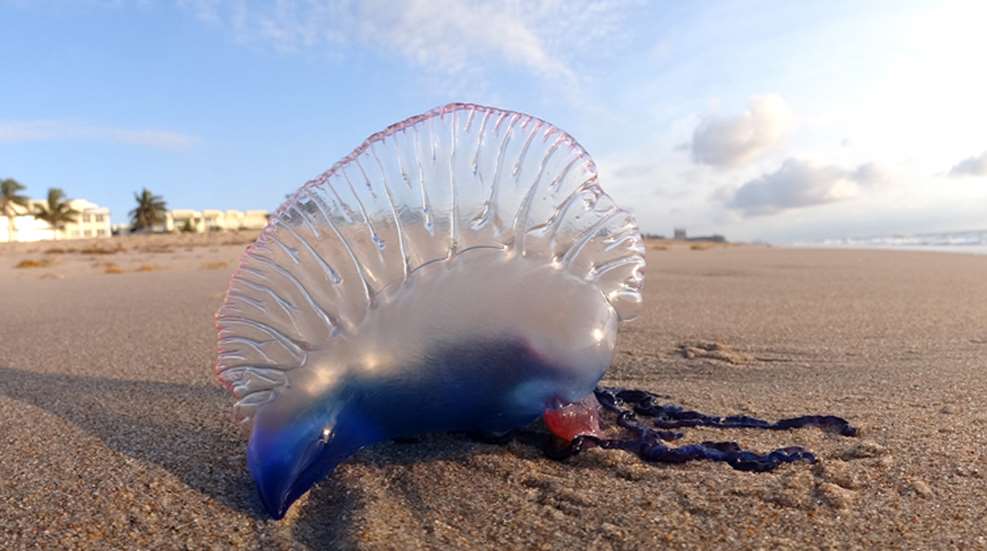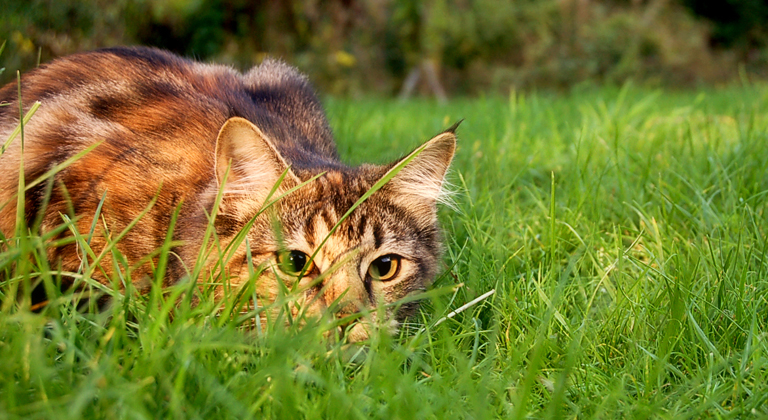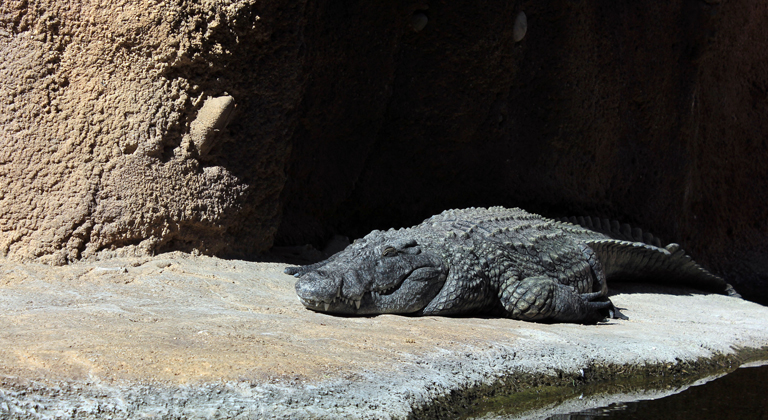** When you buy products through the links on our site, we may earn a commission that supports NRA's mission to protect, preserve and defend the Second Amendment. **

One of the saddest things about the decline of print media, in my opinion, is the dearth of wacky supermarket tabloids. I miss being able to entertain myself with the adventures of Batboy or the latest Elvis sightings while I'm waiting my turn at the cashier. The good news is that with the advent of smart phones and tablets, we can scan the Internet for all things wild and wacky while we kill time in line. Even better is that today's Fun Friday installment of crazy animal facts are completely true...but if you do happen to see Batboy or Bigfoot while you're out and about, don't forget to send us a picture!
1. Four-In-One
You've heard of parasitism, in which one animal feeds on another (like leeches). You've heard of symbiosis, in which one or more animals form a mutually beneficial relationship (like sharks and remoras). What you may not have heard of is siphonophores, which are "animals" that aren't single animals at all, but multiple animals that cannot exist separately. The most famous example of this is the Portuguese Man o'War, which may resemble a jellyfish, but is actually a colony of animals called zooids. These separate creatures each have their own duties: defense, feeding, reproduction and "navigation" by the gas-filled "sail" that floats on the ocean's surface. As interesting as the Portuguese Man o'War is from a biological perspective, you'll want to observe it from a healthy distance: The defensive sting of the venomous nematocysts on the animal's tentacles is quite painful, and can happen even once the Man o'War has been beached or the tentacles have detached from the main body. (Image by Volkan Yuksel)

2. Red In Tooth and Claw
The results are in, and America's most prolific predator is (drumroll, please!)...the housecat? It's true! With an estimated 77 million pet cats in the U.S. (plus an estimated 70 million feral housecats), the domestic cat is not only a ubiquitous predator, it's also an extremely effective one. Although there's really no way to know for sure how many birds and small mammals fall to the humble felis catus, scientists estimate that domestic cats kill hundreds of millions of birds and over a billion small mammals each year. "Belling" your cat won't help; England's The Mammal Society did a study in 1997, and found that the mean kill rate for cats wearing bells was 19, while the rate for "silent" kitties was 15! (Image by Jennifer Barnard)

3. More Than You Can Chew
If you've ever tried to get hold of your dog's squeaky toy when he doesn't want you to, you know that Fido's got a pretty incredible bite. But when it comes to bite force, canids don't even make the top 10. Measuring by pounds per square inch (PSI), the top 3 most powerful bites belong to reptiles: the Nile crocodile at 5,000 psi, the saltwater crocodile at 3,700 psi and the American alligator at 2,125 psi. Although it's true that these reptiles' jaw muscles are nowhere near as strong when it comes to opening their jaws, and that it is theoretically possible to hold their mouths shut with your bare hands, we don't recommend you try it. All crocodilians have powerful neck muscles and it would be quite easy for them to escape your grasp. (That said, it might please you to know that one primate did make the "Top 10" list; a gorilla's bite force clocks in at #7 with 1,300 psi.)

4. Kissin' Cousins
You probably already know that the cheetah is the world's fastest land mammal, with a top speed of 75 miles per hour. What you may not know is that the entire population of cheetahs are all descended from the same handful of individuals. In fact, cheetahs are so genetically similar that unrelated cats can receive skin and organ transplants from one another without anti-rejection drugs! How did their population wind up so inbred? Well, we humans might have had a hand in it...or we might not. About 12,000 years ago, the Quaternary extinction event took place. This was a mass die-off of megafauna such as wooly mammoth, the giant sloth and saber-toothed cats. Although nobody knows for sure whether this extinction was as a result of climate change, human predation or a combination of the two, the upshot was the same: The cheetahs barely made it. It's thought that the population of cheetahs was reduced to just a few dozen.

5. The Need for Speed
Speaking of swift land mammals, although animals like the cheetah and pronghorn antelope are capable of outracing your average commuter car—at least in short bursts—a remarkable number of both predators and prey animals seem to top out right around the 30- to 35-mph mark. Your average housecat, grizzly bears, wild pigs, mule deer, rabbits and jackals all fall in that range. By contrast, the fastest human being alive, Usain Bolt, clocked in at 27.8 mph. For most people, however, even 15 mph is a huge accomplishment. But don't feel bad: Human beings may not be the speedsters of the animal world, but we are incredible endurance runners. Each year in Wales, the Man versus Horse Marathon pits human runners against riders on horseback...and people do win on occasion (especially in hot conditions). (Image by Jothelibrarian)
1. Four-In-One
You've heard of parasitism, in which one animal feeds on another (like leeches). You've heard of symbiosis, in which one or more animals form a mutually beneficial relationship (like sharks and remoras). What you may not have heard of is siphonophores, which are "animals" that aren't single animals at all, but multiple animals that cannot exist separately. The most famous example of this is the Portuguese Man o'War, which may resemble a jellyfish, but is actually a colony of animals called zooids. These separate creatures each have their own duties: defense, feeding, reproduction and "navigation" by the gas-filled "sail" that floats on the ocean's surface. As interesting as the Portuguese Man o'War is from a biological perspective, you'll want to observe it from a healthy distance: The defensive sting of the venomous nematocysts on the animal's tentacles is quite painful, and can happen even once the Man o'War has been beached or the tentacles have detached from the main body. (Image by Volkan Yuksel)

2. Red In Tooth and Claw
The results are in, and America's most prolific predator is (drumroll, please!)...the housecat? It's true! With an estimated 77 million pet cats in the U.S. (plus an estimated 70 million feral housecats), the domestic cat is not only a ubiquitous predator, it's also an extremely effective one. Although there's really no way to know for sure how many birds and small mammals fall to the humble felis catus, scientists estimate that domestic cats kill hundreds of millions of birds and over a billion small mammals each year. "Belling" your cat won't help; England's The Mammal Society did a study in 1997, and found that the mean kill rate for cats wearing bells was 19, while the rate for "silent" kitties was 15! (Image by Jennifer Barnard)

3. More Than You Can Chew
If you've ever tried to get hold of your dog's squeaky toy when he doesn't want you to, you know that Fido's got a pretty incredible bite. But when it comes to bite force, canids don't even make the top 10. Measuring by pounds per square inch (PSI), the top 3 most powerful bites belong to reptiles: the Nile crocodile at 5,000 psi, the saltwater crocodile at 3,700 psi and the American alligator at 2,125 psi. Although it's true that these reptiles' jaw muscles are nowhere near as strong when it comes to opening their jaws, and that it is theoretically possible to hold their mouths shut with your bare hands, we don't recommend you try it. All crocodilians have powerful neck muscles and it would be quite easy for them to escape your grasp. (That said, it might please you to know that one primate did make the "Top 10" list; a gorilla's bite force clocks in at #7 with 1,300 psi.)

4. Kissin' Cousins
You probably already know that the cheetah is the world's fastest land mammal, with a top speed of 75 miles per hour. What you may not know is that the entire population of cheetahs are all descended from the same handful of individuals. In fact, cheetahs are so genetically similar that unrelated cats can receive skin and organ transplants from one another without anti-rejection drugs! How did their population wind up so inbred? Well, we humans might have had a hand in it...or we might not. About 12,000 years ago, the Quaternary extinction event took place. This was a mass die-off of megafauna such as wooly mammoth, the giant sloth and saber-toothed cats. Although nobody knows for sure whether this extinction was as a result of climate change, human predation or a combination of the two, the upshot was the same: The cheetahs barely made it. It's thought that the population of cheetahs was reduced to just a few dozen.

5. The Need for Speed
Speaking of swift land mammals, although animals like the cheetah and pronghorn antelope are capable of outracing your average commuter car—at least in short bursts—a remarkable number of both predators and prey animals seem to top out right around the 30- to 35-mph mark. Your average housecat, grizzly bears, wild pigs, mule deer, rabbits and jackals all fall in that range. By contrast, the fastest human being alive, Usain Bolt, clocked in at 27.8 mph. For most people, however, even 15 mph is a huge accomplishment. But don't feel bad: Human beings may not be the speedsters of the animal world, but we are incredible endurance runners. Each year in Wales, the Man versus Horse Marathon pits human runners against riders on horseback...and people do win on occasion (especially in hot conditions). (Image by Jothelibrarian)







































